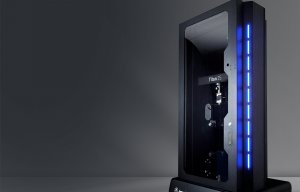
Highest capacity testing with the Titan 25
Emphasis on making testing simple, fast and intuitive.

18th March 2024
Innovation in Textiles
|
United Kingdom
Sophisticated systems for the testing of fibres and advanced materials will be showcased by key members of the British Textile Machinery Association (BTMA) at the forthcoming Techtextil 2024 exhibition which takes place in Frankfurt, Germany, from April 23-26.
James Heal Performance
James Heal, for example, has established strong ties with major producers of technical textiles over many years and with its latest Performance Testing collection of instruments has put the emphasis on making testing simple, fast and intuitive.
The latest James Heal AirPro air permeability tester is used to test the resistance of the flow of air through woven, knitted or nonwoven textiles. Its software offers flexibility with standards and comprehensive reporting options and different test head sizes are available, making it suitable for a range of applications and standards.
The HydroView hydrostatic head tester is meanwhile designed to measure the penetration of water in materials which have an end use that requires water resistance, such as those in the medical, geotextiles and nonwovens sectors. It is also proving essential in the testing of end-use applications for technical textiles ranging from protective gloves, diving suits and winter sports apparel to fishing waders, roofing, tenting, ground sheets and more.

Water repellency is another important function of technical fabrics from a safety and comfort perspective and with the TruRain, James Heal has reduced the volume of wastewater and energy consumed in water repellency tests to a fraction of that of competing products.
James Heal is at stand A40 in Hall 12, at Techtextil 2024.
Visual accuracy
Colour is the prime focus of VeriVide (Hall 12, stand A70) and its systems are widely employed by manufacturers of technical textiles for end-use applications including automotive, aerospace and other transport interior materials, seat belts, airbags, helmets and gloves, and even medical implants and prosthetics.
For non-contact colour measurement and digital imaging, VeriVide’s established DigiEye system collects and processes data that can be communicated and shared instantly, enabling manufacturers, producers and processors to speed up quality control, sustain product integrity and reduce waste. DigiEye also enables the non-contact measurement of curved and textured parts and provides objective and accurate colour data.
Patterned fabric inspection
The precise detection of faults during the production of technical fabrics has recently been significantly advanced with the introduction of the latest WebSpector automated fabric inspection system by Shelton Vision (Hall 12, stand E54)
Building on its market leading vision system for plain, single colour textiles, Shelton’s patent-pending image processing techniques now recognise and adapt to complex patterns – even those on fabrics with significant distortion and deformation.
Fabrics are not rigid and can be sheared or stretched while also being subject to local distortion, but the WebSpector system successfully deals with such anomalies in real time to provide a reliable inspection process at the same levels as plain fabric.
The unique and advanced software techniques ensure a totally clean image, allowing the full detection of faults on fabrics running at high speeds.
While the automotive interiors and one-piece woven airbags sectors remain major destinations for this advanced technology, further finished fabric WebSpector systems are now currently being supplied to manufacturers of performance wear and high-end fashion, denim, outdoor upholstery, sunscreen, mattress ticking, window dressings and even carbon fibre composites.
Splicing
Resource efficiency in the processing of such extremely expensive like carbon and aramid is meanwhile a key benefit of the latest splicing technologies of Airbond (Hall 12, stand E31).
Pneumatic yarn splicing is a clever process established in the textile industry for joining yarns and works by intermingling individual filaments closely together, to make joint which are stronger and flatter than knots.
The patented splicers in Airbond’s latest range are 3D printed, making them both lighter and stronger, and now enable the splicing of yarns in sizes of up to 16,000 tex – compared to the 1,200 tex most splicing machines can handle.
New fibres
Fibre Extrusion Technologies (FET, Hall 12, stand A84) works closely in collaboration with its customers on the development of specific multifilament, monofilament and nonwoven polymers for niche applications – over 70 to date – and designs the bespoke fibre extrusion and spunbond and meltblown nonwoven systems to successfully produce them.
Following the opening of its expanded Fibre Development Centre at the start of 2023, with considerably enhanced facilities more than doubling capacity and increasing efficiency, the company has significantly accelerated the number of technical trials it has conducted for clients.
Expanding markets
Other BTMA members who will be exhibiting at Techtextil 2024 include Avocet (Hall 11, stand B25) the manufacturer of Cetaflam high performance flame retardant (FR) chemicals, Ascotex (Hall 12, stand B41) a specialist in the development and application of yarn guides, and Vandewiele UK (Hall 12, stand D20) the UK arm of Bonas Textile Machinery specialising in high capacity jacquard technology for the weaving industry.
“Techtextil is an essential show for many BTMA members and there are growing opportunities in a number of rapidly expanding markets with exponential growth,” says BTMA CEO Jason Kent. “We are looking forward to some very fruitful meetings and discussions at Techtextil 2024, which is always an essential barometer for gauging where the technical textiles markets are headed next.”
Founded in 1940, the British Textile Machinery Association actively promotes British textile machinery manufacturers and their products to the world. The non-profit organisation acts as a bridge between its members and the increasingly diverse industries within the textile manufacturing sector.

Business intelligence for the fibre, textiles and apparel industries: technologies, innovations, markets, investments, trade policy, sourcing, strategy...
Find out more